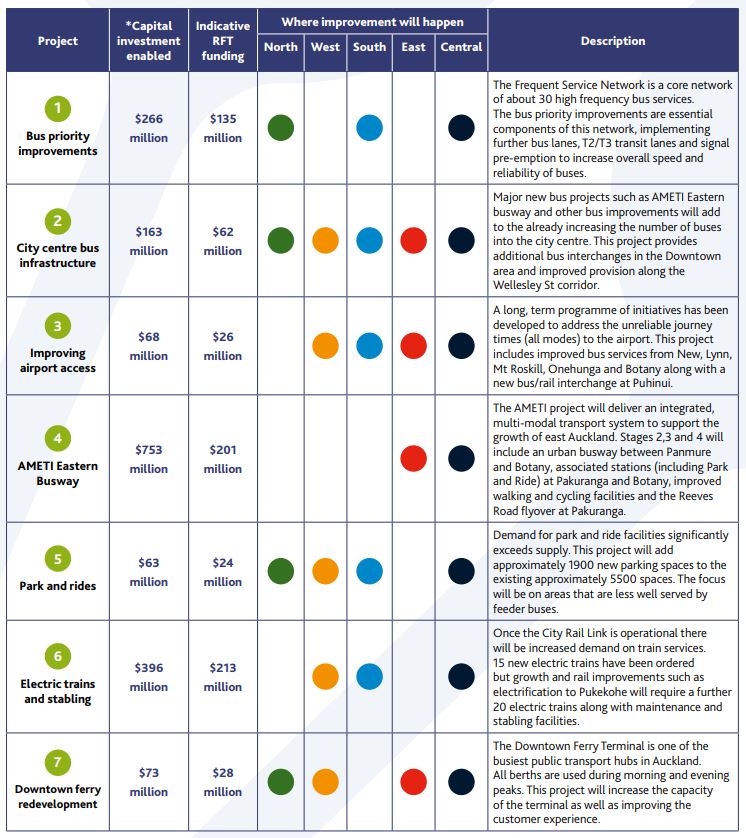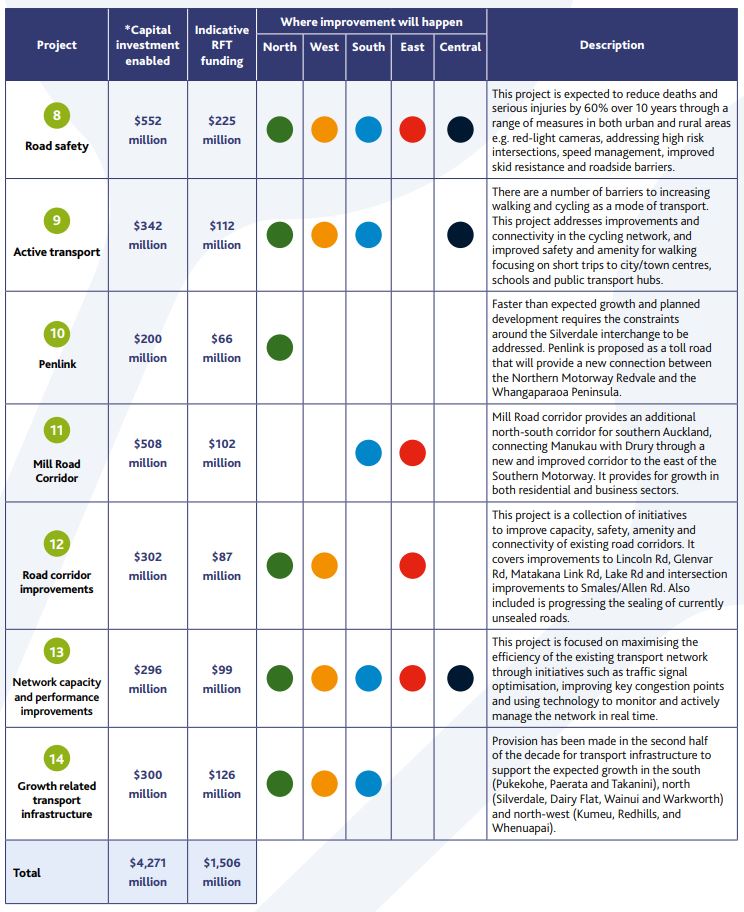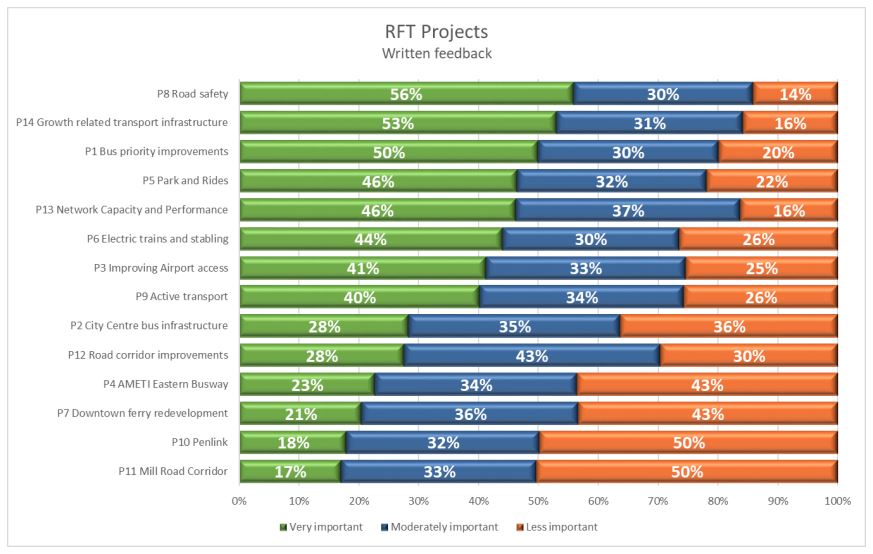Tomorrow the Council will make their final decision on whether to proceed with the Regional Fuel Tax – which is fundamental to delivering the ATAP transport programme by helping to fund the following projects:


As part of the legislative requirements for introducing the fuel tax, the Council undertook consultation earlier this month on the proposal. This was done at the same time as the Regional Land Transport Plan.
This is the second round of public consultation on the Regional Fuel Tax. The first phase took place as part of the Council’s 10 year budget consultation process in March, which included both the normal feedback process and a fairly weighty scientific poll of 4000 people. Across these three, it seems that there’s a relatively even split between those who support the idea and those who oppose it. Drawing more specific conclusions than this is a bit tricky, given the large number of pro-forma submissions – as the Regional Fuel Tax paper going to the Council on Thursday highlights:

The paper compares these results with previous consultation on the 10 year budget:
As set out above, as part of the 10-year Budget consultation, the Council also sought the community’s views on the introduction of an RFT of 10 cents per litre plus GST to fund transport infrastructure in Auckland. Colmar Brunton were also used to conduct a representative survey of the key questions in the LTP, one of which was the RFT. Written responses to the public consultation on the RFT showed 46 per cent support, 48 per cent did not support and 6 per cent chose other. When these statistics were adjusted by excluding all pro forma submissions, the results were 48 per cent support, 43 per cent did not support and 9 per cent other. The Colmar Brunton survey found 52 per cent support for the RFT, 43 per cent did not support and 5 per cent chose other. More detail on both the public feedback and the Colmar Brunton survey is publicly available on the Council website.
It is noted that both of these results preceded the government’s announcement of an increase in fuel excise duty, however, the results of public consultation, after adjusting for proformas, is very similar.
What’s perhaps more interesting than the numbers game of support or opposition, is the split in support across the different projects proposed to be funded by the Regional Fuel Tax:

I guess Mill Road and Penlink aren’t that popular after all, whereas safety is absolutely where the public want to see extra investment. Maybe we could chop out the two least popular projects and reduce the fuel tax to 9c a litre? 😉
Looking through some of the more detailed submissions, especially from Local Boards, it’s clear that there is a widespread concern about affordability impacts of the fuel tax. It is certainly unfortunate that the Regional Fuel Tax comes at time when we are facing unusually high fuel prices. Nevertheless, 15 of the 21 Local Board support the proposal with only two (Howick and Manurewa) opposing it. Great Barrier, Papakura, Upper Harbour and Waiheke Local Board provided comment, but not a specific position.
As I discussed in detail last week, these affordability and equity concerns are real and reasonable. However, it’s important to remember that the Regional Fuel Tax will make up around 15% of the Council’s expenditure on transport over the next decade ($1.5 billion out of around $10 billion in total). This means that 85% will still come from normal sources like rates, which is more progressive (while coming with a host of potentially unfair elements itself). I’m hopeful the Regional Fuel Tax will proceed, as otherwise it will be impossible to make major progress on improving transport in Auckland.

 Processing...
Processing...
Ummm the Mill Road project is the $500m basic upgrade and a new interchange at Drury South not the $1b gold plated motorway Judith Collins and National wanted.
That said even the high level of regional opposition to Mill Road should dent any one from National or Council (looking at you Newman) wanting the Motorway option.
As much as I loath spending money building motorways, the traffic south of Papakura and north of it is horrendous and will only worsen with housing developments in that part of Auckland. An alternative is needed.
And a 4 lane defacto motorway is not it
Congestion begets congestion and adding a 4 laner will only make it worse as well as having east west rat running through residential Takanini.
If we want to get on top of the motorway issue then transit needs to step up within the South and into the Waikato
Agree. And $500m is a big sum that should be going towards a real alternative, not more traffic-inducing roads.
High speed regional rail!
Possibly. Or another corridor.
A 3 lane motorway is plenty enough for that – I live in this area and yes the traffic is frustrating, but a parallel motorway (mill road) in my opinion, is not the answer.
+1 (I also live in the area)
More road capacity sends a signal that more people can live and drive. Transport begets land use which then begets transport.
This fuel tax is a drop in the tank versus blatant profiteering by oil companies.
How is it for example, that BP, (think price rise manipulation in Otaki), can charge upwards of a 30 cent premium for high octane over 91? Rip off……
At least this tax will go into holistic improvements for Aucklanders and not into shareholder pockets and not solely into motorways like the previous governments similar fuel tax rises.
They can charge so much xtra cause premium is generally required only for premium european vehicles. Those people (in NZ) can generally pay more. It’s like the opposite of a student discount.
In europe on the other hand, europen vehicles are bog standard as is 95 octane
Its actually BP alone who do this, especially 98 octane. The worst I have seen is a 39 cent premium which is pure greed.
A lot of Japanese cars (both new and used imports) now require 95. Basically any car with a turbo also requires it (and a lot of manufacturers are building smaller engines with a turbo charger to improve efficiency). At most 95 should only be $0.12 more and 98 $0.20 more but really they should only be $0.08 and $0.14 more respectively.
@Matt: As for Penlink, of course it’s going to be near the bottom as it has a large benefit for a smaller amount of people vs some of the other projects that have a smaller benefit but cover most of the population. Do you think someone in South Auckland is going to be thrilled about Penlink?
Because people are clearly stupid enough to fill up with higher octane there and pay the higher price. When I had a car that required 95+ I always went to Z or Caltex.
Pleased to hear that road safety tops the priority list of Regional Fuel Tax initiatives. Therefore it’s vital that we press on with the RFT to address the appalling rise of road deaths in the Auckland region. A rise that is five times greater than the increase in new vehicles on the roads.
If the RFT fuel tax is also the difference between driving or taking public transport, walking or cycling, then good. The productivity losses for Auckland every year are massive and it’s mostly due to Auckland being a car congested mess … fortunately that can be turned around.
Most like the impact of the RFT on the region will be minimal as fuel prices will most likely be offset by the oil companies (who make massive profit margins anyways) to keep them competitive. The benefits of the RFT however, easily outweigh the negatives.
It’s good that the public understand the need for safety improvements, but polls really shouldn’t be a part of allocating funds to safety projects at this level. People seem overly concerned about the recent rise in DSI when the rate was too high to begin with, and that seems to be because of how the media is framing it.
I look forward to seeing how the public’s preferences might change once AT has carried out the 45 recommendations of the Road Safety Business Improvement Review, including the public education aspects. I’d also like to know how the public’s preferences would change if NZTA were to run a campaign explaining how induced traffic works and why road-building has brought Auckland to the state it is in.
I don’t thunk we should read too much into the “priority” order given the various initiatives in the consultation. The bottom four, AMETI, the downtown ferry terminal, Penlink and Mill Road are all very much “minority interest” initiatives for most of the public. Many people won’t even know what AMETI or Penlink are, or where Mill Road is located and why it is considered important, so it’s no surprise that they are ranked as low as they are. And the ferry terminal redevelopment is probably of interest mainly to those who use the ferries. Most of the other initiatives are ones that most people could identify with, so it’s n surprise that they ranked higher.
Interesting that road safety comes out above any other initiative, and that growth-related infrastructure is ranked second (which I would spin as a mandate for PT initiatives, not road).
That was always a problem with the term “growth-related infrastructure” anyway. How should you answer it when you know your answer could be misconstrued. Ask mud, get mud.
Frustratingly all the bureaucrats seem to interpret ‘growth related infrastructure’ as strictly meaning ‘sprawl inducing subsidy’. In this they are still taking their lead from the previous government, and from habit. Even though we’ve had 20+ years of 75% up and 25% out growth, despite these inducements and restrictions on building within the existing urban area…
So the bureaucrats need to listen: the public want infrastructure to support growth. Road capacity will lead to increased traffic problems, and the public don’t want increased traffic problems. It’ll also lead to increased DSI and increased carbon emissions, which we have committed to lowering.
The only way to interpret the public’s preference for growth-related infrastructure responsibly is that we need to build public and active transport infrastructure to support growth.
Patrick, I completely agree, so Greater Auckland needs to engage with people, proposing better solutions as they have always done. Great progress has been made on the big stuff like RTN (building the networks), but maybe now there needs to be discussion on using the networks. What is going to induce ridership to move from the current 4% to achieve the last AT target of 7% over the next 10 years? What is going to increase it beyond this to actually reduce congestion?
When you asked somebody who doesn’t live in Howick to fund AMETI, the answer is going to be less support.
What do you think most people thought “Network capacity and performance” really meant? 83% support is pretty high for this one, given its ‘catch-all’ nature. Here are some things the RLTP described under this section:
“increasing the number of people who can travel through key routes and corridors” = PT
“improving connectivity to key public transport hubs and interchanges” = active mode and PT
“improving the efficiency and coordination of traffic signals to improve throughput and reduce delays” = reducing pedestrian priority
“using dynamic traffic lanes to improve peak traffic flows” – but do these dynamic lanes replace static lanes to allow road reallocation for cycling? Or do they just add peak capacity for traffic, inducing traffic elsewhere, thus reducing cycling safety?
“providing priority for freight on key freight connections” means, what, truck lanes? Long traffic phases for trucks as they take a long time to get up to speed?
Again, wide-ranging possibilities of what people thought they were supporting…
+1 for your analysis.
“Network capacity and performance”
Exactly right Heidi – this is the high level consultation that happens. Many people end up voting for something they know nothing of. I didn’t understand it – I formed the view Council probably intended it to be oblique – so I voted against it.
Everyone loves safety until it blocks up the road to work and is then it is suddenly considered overkill and pandering to a small but vocal minority.
Some projects like ATEMI and Downtown ferry only benefit locally.
However those projects are funded by the whole region regardless they use it or not. That could explain why these projects has less regional support.
Yes
Mill Road should really be renamed “Quarry Road” cause that’s what is driving it!
There has not been any evidence of land acquisition to date but it is hard to see how they will be able to fit in the illustrated road formation on the existing road reserve.
The proposed Alfriston intersection needs a lot of redesign or removal/relocation of the school. The same regarding the passage through Papakura and there is no detail of how they intend to bisect the east side of Papakura and facilitate the passage of school children over the motorway. This hole proposal is full of holes.
Once the southern motorway work is complete there may well be no need for this connection except for quarry traffic.